The capital’s air quality has plunged into the “severe” category, raising alarms nationwide and beyond. Over the past week, Delhi’s Air Quality Index (AQI) has consistently exceeded 400, compelling the Commission for Air Quality Management (CAQM) to activate Stage-IV of the Graded Response Action Plan (GRAP). This phase includes drastic measures such as banning truck entry into the city and halting construction activities at public projects to curb further air quality deterioration.
The AQI is a numerical representation of air pollution, combining multiple parameters. Particulate matter (PM) is a primary focus. PM2.5, particulate matter smaller than 2.5 micrometers, is particularly hazardous as it can penetrate deep into the lungs and bloodstream.
An analysis of daily AQI and PM2.5 concentration data from the Central Pollution Control Board (CPCB) reveals a sustained crisis.
| Date | AQI | PM2.5 (µg/m³) | Category |
|---|---|---|---|
| November 1 | 339 | 220.64 | Very Poor |
| November 2 | 316 | 219.88 | Very Poor |
| November 3 | 382 | 224.98 | Very Poor |
| November 4 | 381 | 233.77 | Very Poor |
| November 5 | 373 | 213.75 | Very Poor |
| November 6 | 352 | 206.66 | Very Poor |
| November 7 | 377 | 233.99 | Very Poor |
| November 8 | 380 | 214.16 | Very Poor |
| November 9 | 352 | 184.83 | Very Poor |
| November 10 | 334 | 179.29 | Very Poor |
| November 11 | 352 | 189.74 | Very Poor |
| November 12 | 334 | 191.60 | Very Poor |
| November 13 | 418 | 395.09 | Severe |
| November 14 | 424 | 280.46 | Severe |
| November 15 | 396 | 273.63 | Very Poor |
| November 16 | 417 | 363.20 | Severe |
| November 17 | 441 | 428.58 | Severe |
India’s Central Pollution Control Board (CPCB) sets the safe annual PM2.5 limit at 40 µg/m³ and the daily limit at 60 µg/m³. However, the World Health Organization (WHO) recommends stricter limits: an annual average of 5 µg/m³ and a daily average of 15 µg/m³. Delhi’s PM2.5 concentration this November has frequently exceeded 200 µg/m³, with spikes surpassing 400 µg/m³ on the worst days, far exceeding both national and international safety thresholds.
Experts warn about the health risks of prolonged exposure to hazardous air. Dr. Jemilah Mahmood, Executive Director of the Sunway Centre for Planetary Health, Malaysia, emphasized the global dimension of this crisis,
“Delhi’s toxic air shows that air pollution is a public health emergency. Millions in South Asia and Southeast Asia, millions are breathing poisoned air due to our dependence on fossil fuels. This is damaging our lungs; fueling the planetary health crisis, undermining our economies, and stealing quality years from our lives. Ending fossil fuel reliance is essential for our survival and future generations.”
Dr. Arvind Kumar, a prominent chest surgeon and environmental health advocate, highlighted the human toll of Delhi’s air crisis,
Polluted air is an invisible killer, infiltrating every breath we take and quietly wreaking havoc on our health. From triggering asthma attacks in children to fuelling heart disease, lung cancer, and cognitive decline, the impact of emissions transcends generations, leaving vulnerable communities to bear the brunt. 8.1 million premature deaths are attributable to air pollution. We need a concerted political effort to end this catastrophe, phase out fossil fuels, and prioritize clean energy. Without decisive action, we are sacrificing both our health and our future.
The problem extends beyond Delhi. Air pollution affects countries in the Indo-Gangetic plains and the larger Hindu Kush Himalayan (HKH) region. At the 29th Conference of Parties (COP29) in Baku, Azerbaijan, Naresh Pal Gangwar, joint secretary at India’s Ministry of Environment, Forest, and Climate Change, urged regional collaboration:
“We need proactive, collaborative steps across borders, particularly with Pakistan and Bangladesh, to manage and mitigate air pollution in the Indo-Gangetic airshed.”
Delhi’s air pollution crisis underscores the urgency of transitioning to clean energy, reducing reliance on fossil fuels, and enforcing stringent emission controls. While measures like GRAP provide short-term relief, experts argue lasting change requires systemic reforms and international cooperation.
As Delhi faces its annual pollution emergency, the need for sustainable solutions is urgent. This crisis reminds us that air quality is not just a local issue—it’s a public health and environmental priority for the region and the planet.
Support us to keep independent environmental journalism alive in India.
Keep Reading
Watch: Kashmir experiences first snowfall of season after dry spell
Amarnath Yatra: Tackling rising death toll from extreme weather events
Tourists arrival in Kashmir break records, a need to regulate it?
From tourist paradise to waste wasteland: Sindh River Cry for help
Follow Ground Report on X, Instagram and Facebook for environmental and underreported stories from the margins. Give us feedback on our email id greport2018@gmail.com.
Don’t forget to Subscribe to our weekly newsletter, Join our community on WhatsApp, and Follow our YouTube Channel for video stories.






